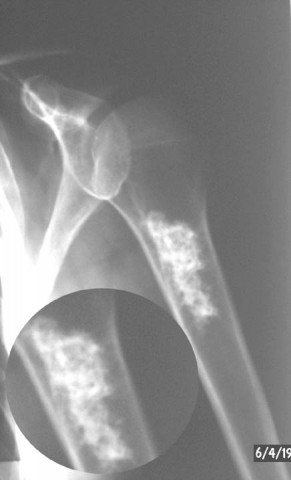Case Identification
Case ID Number
Tumor Type
Body region
Benign or Malignant
Clinical case information
Case presentation
A 52 year old man had a six week history of aching pain in the shoulder at rest and with activities. On exam, there was pain and tenderness over the proximal humerus and the anterolateral arm, as well as pain with abduction and limitation of motion of the shoulder.
The lesion has a latent appearance and there is no sign of progressive growth. This coupled with the central, metaphyseal location, as well as the dense matrix calcification showing "rings and arcs" (see inset images) identify this lesion as an enchondroma.
Radiological findings:
The bone scan shows mild uptake in the lesion, which is expected since the natural tendency of cartilage in an enchondroma is to become replaced by bone over time. This leads to variable uptake on bone scans that should not be interpreted as malignant growth. The enchondroma should be followed with intermittent radiographs for one to two years to insure there is no progressive change. Definite growth in an enchondroma after skeletal maturity (as distinct from progressive ossification without size change) is a sign of neoplastic activity and requires a full work - up. Rotator cuff / subacromial bursa pathology might also cause the symptoms observed.
Special Features of this Case:
To resolve the issue of the patient's pain, remember that all of the symptoms can be explained on the basis of rotator cuff tendonitis or subacromial bursitis (call it whatever you prefer). To identify the origin of the pain, this patient had a diagnostic injection of marcaine placed into the subacromial bursa. His pain was completely (and temporarily) resolved. This simple but valuable diagnostic manouver helped pinpoint the origin of the patient's pain and eliminated the "red herring" of the enchondroma. The clinician can reassure the patient about the lesion and focus the treatment on the rotator cuff pathology.
Image

Secret Tumor Name
Case ID Number
Image Types
Image modality
Tumor Name
Benign or Malignant









